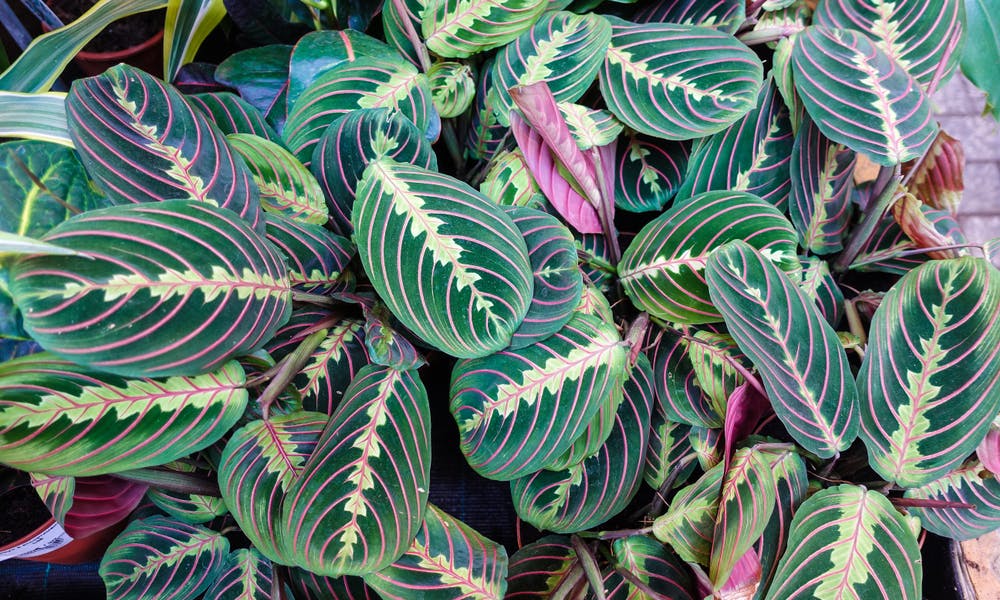Maranta leuconeura, or the prayer plant, is a perennial monocotyledonous plant that belongs to the genus Marantaceae. This plant is also occasionally called “Calathea leuconeura.” In fact, the calathes is similar to martens and are easily mistaken, but still slightly dissimilar.
Maranta leuconeura is originally from the rainforests of Brazil. It is a stunning house plant, as long as it is given sufficient humidity. Also, it is a bit easier to cultivate than calathes.
The maranta leuconeura is a rusty rhizomatous herb with small, roughly crawling branches. Every stem carries five to six leaves with a rigid and long stalk. The leaf blade is 12 cm in length, has an obovate form, and is beautifully decorated with various regular spots. The variety is fairly diverse, and the foliage is more or less densely tessellated in a range of colors. This maranta grows over time to a leaf mat of 30 to 40 cm high and, in some cases, more.
In this article, we are going to cover several points, such as:
* How to Grow a Prayer Plant?
* How to Maintain a Prayer Plant?
* Tips on Keeping the Prayer Plant Alive.
* More about the Prayer Plant.
How to Grow a Prayer Plant?
As a house plant, you should put marantas in acidic and well-drained soil. However, marantha arundinaria, a variation, does tolerate siltier garden soil. Such plants appreciate medium to bright shade.
They are irrigated with water to maintain their ground moist but be aware of keeping their foliage above the water. In winter, the ground can handle dryness and only need about two irrigations. The plant should stay quite humid around the leaves. For that, spray it more regularly.
In pots, maranta needs regular nourishment with the help of diluted fertilizer. You should replace the soil every two to three years in the spring. When you do this, you should take out the old roots and rhizomes to avoid damaging the rest.
How to Maintain a Prayer Plant?
Always keep the soil fresh in all periods of the year. You should do it like this: two to three weekly waterings during the summer, one during the winter.
Use a daily spray for the foliage in the summer, once or twice a week during the winter. The hotter the environment, the more humidity your plant is going to need.
Adding a bit of wood charcoal to the soil helps reduce the possibility of rotting and increases the coloring of the leaves. Be careful because red-colored spiders could attack the plant in hot and dry climates.
Also, place your plant out of the sun’s rays. You may hang or position your prayer plant close to a large window so that it is indirectly exposed to sunlight. Do not leave your plant in the direct sunlight, as the leaves become white from the sunlight exposure.
The maximum room temperature must be in the range of 18 to 24 degrees C for your plant’s growth.
Tips on Keeping the Prayer Plant Alive
First, verify if the plant can still survive if it has suffered from considerable damage. Scrape the base of its stem with the end of your fingernail; if there is green below the first layer, it means that you can still save your plant. If you find brown in the middle of the stem, this means that this part of the stem is dead. After you have found a dead part of the stem, you must remove it.
As you surely know, sun exposure is an essential factor for the survival of the plant. Nevertheless, all plants are different and do not all need to be located in the same place. So make sure to detect the perfect place to put your plant in.
To restore your plant correctly, prepare a good and nutritious dish for it. Check out a garden store and ask for a suitable nutrient. The vendors can tell you the fertilizer that is most efficient for your plant.
More about the Prayer Plant
The prayer plant is similar to the arrow-root (Maranta arundinacea). In the natural environment, the maranta can grow to several meters in height and can be seen in South and Central America, particularly in the Brazilian rainforest.
The maranta is often called “the sleeper” as its leaves curl up at night. It is a vivacious houseplant that loves the warmth and bright places.
The maranta owes its origin to Bartolomeo Maranta (1500-1571), an Italian physician, a botanist as well as a professor of comparative literature. Its nickname is “plant of the Ten Commandments,” evoking the 10 dark green patches of the leaves. However, its best name is probably the “prayer plant,” due to its leaves that start to turn in the evening. Then, the leaves close by themselves, just like the hands when praying. Seeing this plant is an excellent way to reflect and show gratitude before going to sleep for a day that has passed.
The night sleeper, or prayer plant (Maranta leuconeura), is the ideal evergreen for rooms in the house where light levels are typically low. It has oval, bright grey-green foliage, or pink patches/stripes. Sleepers can be planted in hanging baskets or placed on a desk. In the night or on cloudy days, the leaves are folded in a manner reminiscent of a praying person’s hands. You can maintain this plant indoors as a houseplant or outdoors, preferably in tropical areas.
Prayer plant is known to be used a lot in house designs due to its beauty. If you happen to have one of these in your house, you should know and be careful about how to take care of it. Prayer plant care is not simple, but the results are satisfying and worthy.
